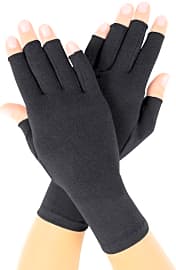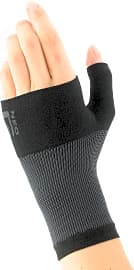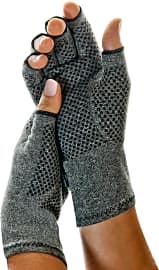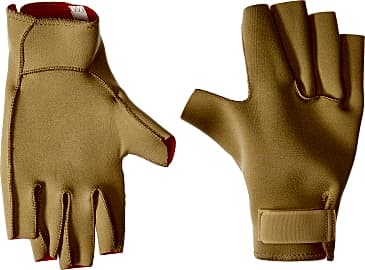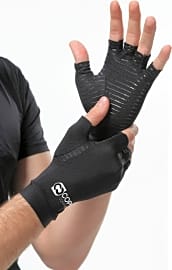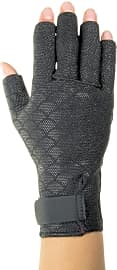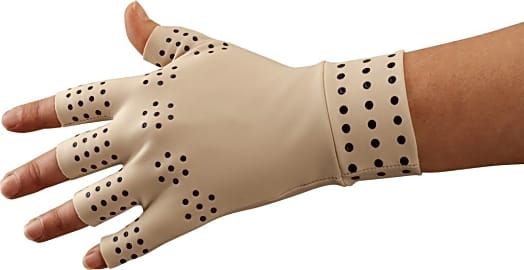The 10 Best Arthritis Gloves

This wiki has been updated 34 times since it was first published in October of 2016. Arthritis is an insidious condition that causes pain and limits mobility, but these gloves are specially designed to reduce physical suffering in the hands and wrists by providing warmth, increasing circulation, and relieving aches and stiffness. They’re sold in a range of designs that provide support, compression, and heat, so be sure to talk with your doctor about which pair is right for you. When users buy our independently chosen editorial selections, we may earn commissions to help fund the Wiki.
Editor's Notes
January 01, 2020:
Around 15% of the world’s adult population suffers from osteoarthritis, and relief can be hard to find for this chronic, often debilitating condition. These arthritis gloves are designed to provide temporary relief through compression, heat, or support, which can help you get through your necessary daily activities like cooking, working, performing household chores, walking the dog, and even playing some sports.
Coming on board in today’s update is the ComfyBrace Fingerless, which many users say will hold up well to extensive use. They come in a neutral gray color, which many prefer over beige as it hides dirt more easily. Speaking of which, they’re easy to hand-wash and will air dry quickly, so you can get them back on for your housework, office work, and more. They provide a snug, contoured fit and are made of comfortable, moisture-wicking fabric.
For another choice that are as durable as they are soft – and these ones are machine washable – look to the Dr. Frederick's Original, which provide full coverage of the wrist and are designed to allow flexing of the fingers without pinching of the blood vessels and nerves, which likely will make tasks easier like opening a jar or tying your shoes. Their cotton-spandex blend will help ensure your hands don’t sweat, and the single-seam construction makes them comfortable for those who wish to wear them for long periods of time. Their extended tip-free finger design allows you to type and write easily while still providing coverage of all of the finger joints.
A couple of the selections on our list are designed for those who believe in the benefits of alternative therapies. The Copper Compression are advertised as a solution for remedying common ailments like carpal tunnel syndrome and tendonitis, and they’re comfortable as well, thanks to their nylon and spandex blend. For those who believe in magnetic therapy for treating their pain, the Dr. Leonard’s EasyComforts are worth a look. Their built-in magnets are said to sooth the hands by increasing blood flow. For more magnetic products that are marketed as a way of easing aches and pains and achieving general well-being, check out our list of best magnetic bracelets.
As already noted, always check with your physician before beginning treatment with any of these products, as he or she can decide whether they’re safe and suitable for your specific medical needs.
Special Honors
DonJoy Advantage These open-fingertip, lightweight compression gloves are equipped with an adjustable wrist strap that aids in freedom of movement. They’re made from soft, yet durable, nylon and poly fabric. Their silicon grippers make them easy to wear for a variety of activities from household chores to sports. The sleeve design makes them quick to slip on and remove. They come in three sizes and are to be washed by hand in warm water with mild soap, and air-dried. donjoyperformance.com
What Causes Arthritis?
But have you ever wondered what causes arthritis, and why certain people seem to be more prone to it than others?
If you or someone you love has ever suffered from arthritis, then you know how painful and debilitating it can be. Even the simplest tasks can become agonizing, as it feels like your body's betraying you with every movement. But have you ever wondered what causes arthritis, and why certain people seem to be more prone to it than others?
Before we get into the causes of the disease, it may be helpful to define what it is. Arthritis is a breakdown of cartilage in the joints, and since cartilage is what prevents your bones from rubbing against each other, it's easy to see how losing it can cause extreme pain.
There are different types of arthritis, with the most common being OA (and before you ask, it stands for "osteoarthritis," not "old age"). OA is caused by normal wear and tear, and injuries can contribute to it, which is why you sometimes see retired athletes struggling to get around. Heredity plays a part in the onset of OA, as well.
The other common type is RA, or rheumatoid arthritis. This is actually an autoimmune disease, in which your body misidentifies your soft tissue as an enemy and attacks it. Soon, the cartilage and synovial fluid in your joints is all used up, fallen victim to friendly fire, and the end result is a potentially crippling limitation of your mobility.
The first signs of arthritis include stiffness and pain in the joints, as well as limited range of motion. You may notice your joints start to swell and turn red, especially around your wrists and ankles. RA sufferers may also experience a lack of appetite, fever, and fatigue, similar to how fighting off an infection feels (because that's exactly what your body thinks it's doing).
While there is not yet a cure for arthritis, there are certain things you can do to mitigate the pain (like arthritis gloves), which we'll get into below.
How Arthritis Gloves Work
Many people have found relief through wearing arthritis gloves, which are specially designed to help reduce some of the pain and swelling caused by the disease. It may seem strange that something as simple as a pair of gloves could help, but there's some sound reasoning behind it.
Many people have found relief through wearing arthritis gloves, which are specially designed to help reduce some of the pain and swelling caused by the disease.
One of the primary benefits of wearing gloves is that they increase warmth (it's a good thing you had me here to tell you that). Heat is very beneficial for loosening up and relaxing creaky joints, so keeping your hands toasty will help reduce pain and stiffness.
Warmth can help increase blood flow to the affected area as well, which floods it with oxygen and nourishing minerals. This is excellent for the long-term care of your condition, and can potentially help slow down the disease's progression.
Many gloves are infused with healing materials like copper or magnets. While science has yet to confirm that either of these treatments is effective for treating arthritis, many people swear by them. Either way, there's little risk in trying it, and if you find a pair of gloves that is helpful on its own, the magnet or copper could serve as an added bonus.
Even if they don't reduce pain or swelling, the gloves can still be helpful for people who have difficulty with their grip as a result of the disease. Wearing them can assist with basic tasks like opening bottles or holding heavy objects. While this might not provide health benefits, it gives sufferers a sense of control in their lives, and reduces feelings of helplessness.
Tips For Controlling Your Arthritis
While arthritis can affect your ability to do some of the things you previously enjoyed, there's no reason why it has to completely ruin your life. There are ways to control the pain and discomfort enough that you can still participate in many of your favorite activities.
The heavier you are, the more stress you'll put on your joints, so try to limit your calories and keep your activity level high.
One of the most important things you can do is to stay active, even on days when you don't feel like moving. Swimming is a great form of low-impact exercise, and yoga can be ideal for preserving your flexibility while also lowering your stress levels. Just take it easy, and listen to your body (listening to your doctor is probably a good idea, too).
Likewise, keeping a healthy weight is absolutely essential. The heavier you are, the more stress you'll put on your joints, so try to limit your calories and keep your activity level high.
Of course, what you eat is as important as how much you eat. Cold-water fish are filled with inflammation-fighting fatty acids, so try to get more of them in your diet. Nuts and seeds are also good, for the same reason, and you already know that you should be eating lots of fruits and veggies. Stay away from sugars, fatty foods, and refined carbs, and if you're still smoking, now's the perfect time to stop.
Getting plenty of rest is a must, as that's when your body repairs itself. Try to get at least eight hours, and if your pain keeps you awake, talk to your doctor about ways to control your discomfort so that you can rest.
Arthritis is no picnic, but it doesn't have to mean that you can't enjoy life. Take care of yourself, and your joints will thank you...or at the very least they might leave you alone for awhile.




